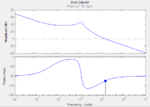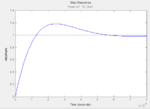power_pwer
Junior Member level 1
hello,everyone
i am facing a problem that make me confused when i am modeling a voltage-mode buck converter.i got a phrase margin of 67degree as the figure"bode_67"shows,however i got a step response as the figure"step_67" shows.
the two plots comfuse me a lot because many meterial told me that the output response would rise up slowly to the final value as long as the phrase margin is higher than 60degree.but figure "step_67" shows a overshoot when its phrase margin is 67.
why does my plot conflict with that conclusion? can anyone help me?
i am facing a problem that make me confused when i am modeling a voltage-mode buck converter.i got a phrase margin of 67degree as the figure"bode_67"shows,however i got a step response as the figure"step_67" shows.
the two plots comfuse me a lot because many meterial told me that the output response would rise up slowly to the final value as long as the phrase margin is higher than 60degree.but figure "step_67" shows a overshoot when its phrase margin is 67.
why does my plot conflict with that conclusion? can anyone help me?


